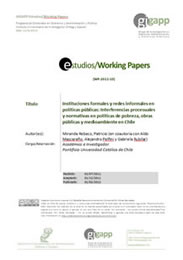Nuevos riesgos sociales y reformas del Estado de bienestar en Noruega y España
Resumen
El Proyecto NorSpaR tiene como objetivo analizar las principales iniciativas de políticas públicas mediante las cuales Noruega y España enfrentan los nuevos desafíos sociales y económicos derivados de los llamados Nuevos riesgos sociales (NSR). Aunque ambos países presentan diferencias significativas en sus entornos institucionales (como la membresía española de la UE), o su pertenencia a diversos tipos de regímenes de bienestar (Noruega generalmente se incluye en el régimen nórdico, mientras que España es parte del mediterráneo), ambos países comparten una Interés común en abordar los desafíos antes mencionados manteniendo la cohesión social. En la última década, los gobiernos de ambos países han tratado de responder a esos desafíos reformando sus mercados laborales, adaptando sus esquemas de desempleo, así como sus políticas de género, familia y cuidado a largo plazo. El análisis cubierto en este proyecto incluye tres áreas de políticas públicas que abordan la NSR. Primero, la dependencia es uno de los desafíos más abrumadores para las sociedades postindustriales que experimentan el envejecimiento de la población y con un número creciente de personas frágiles que necesitan atención. Esta situación está obligando a los gobiernos a repensar sus políticas de cuidado a largo plazo. En segundo lugar, los programas públicos de familia y género deben responder a las crecientes dificultades de las familias para conciliar la vida profesional y familiar. Tercero, en la transición a un orden postindustrial, y en un contexto de desempleo masivo, los sistemas de protección social tienen una renovada prominencia. Junto con las llamadas políticas pasivas que ofrecen apoyo financiero a los desempleados, las políticas activas del mercado laboral están orientadas a que las personas vuelvan a trabajar. En nuestro análisis, intentamos encontrar respuestas a las siguientes preguntas: ¿Cuáles son los desafíos que cada una de estas políticas ha tratado de abordar en los últimos años? ¿Cómo han evolucionado estas políticas? ¿Qué tipo de reformas se han implementado y cuáles se han descuidado? ¿Se han modificado los objetivos y metas de las políticas de los programas de asistencia social de manera significativa? ¿Han cambiado las herramientas políticas (servicios, transferencias, financiamiento o modelos de provisión)? ¿En qué medida han tenido éxito estas políticas para hacer frente a los problemas sociales y económicos? ¿En qué medida existe una demanda social a favor de estos cambios? ¿Cuáles son los principales actores políticos y sociales que intervienen como partes interesadas en estas políticas? Finalmente, ¿cuáles son las principales similitudes y diferencias existentes entre los dos países? ¿Hasta qué punto hay propuestas de políticas que puedan viajar fácilmente entre ellas? ¿Podrían fomentar intercambios de información mutuamente enriquecedores?
Descargas
Citas
Brooks C. and J. Manza (2006) Why do Welfare States persist? The Journal of Politics 68(4): 816-827.
De la Porte, C. and D. Natali (2014) “Altered Europeanisation of Pension reform in the context of the Great Recession: Denmark and Italy Compared”, West European Politics, 37(4):732-749.
Ebbinghaus, B. (1999) “Does a European Social Model Exist and Can it Survive?”. In G. Huemer, M. Mesch y F. Traxler (eds.) The Role of Employer Associations and Labor Unions in the EMU. Institutional Requirements for European Economic Policies, Aldershot: Ashgate, 1-26
Esping-Andersen, G. (1990) The Three Worlds of Welfare Capitalism. Cambridge: Policy Press.
European Commission (2014) “Employment Policy beyond the Crisis”. Social Europe Guide. Vol. 8
Eurostat. 2012. Available at: http://goo.gl/wz0pq1
Eurobarometer. 2007. Health and long-term care in the European Union. European Commission. Available at: http://goo.gl/qbUpJF.
Ferrera, M. (2007) “Recasting European Welfare States: An Introduction”, West European Politics, 23:2, 1-10
Fundación Alternativas (2013) Informe sobre la desigualdad en España 2013. Madrid: Fundación Alternativas.
Hjern, M. and A. Schanabel (2012) “Social cohesion and the welfare State: how heterogeneity influences welfare attitudes”. In H. Ervasti, J. Goul Andersen, T. Fridberg and K. Ringdal The Future of the Welfare State. Social Policy Attitudes and Social Capital in Europe. Cheltenham: Edward Elgar. 172-194.
Hicks, A. and G. Esping-Andersen, G. (2005) “Comparative and Historical Studies of Public Policy and the Welfare State” in Janoski, T. Alford, R. Hicks, A. and Schwartz, M. A. The Handbook of Political Sociology. States, Civl Societies, and Globalization. Cambridge: Cambridge University Press. 509-525.
Del Pino, E. (2013) “The Spanish Welfare State from Zapatero to Rajoy: Recalibration to Retrenchment” in A. Botti & B. N. Field, eds. Politics and Society in Contemporary Spain: From Zapatero to Rajoy. New York: Palgrave.
Ferrera, M. (1996) “The Southern Model of welfare in Social Europe”. Journal of European Social Policy, 6 (1), 17–37.
Kautto, M. (2010), The Nordic countries, en F. G. Castles, S. Leibfried, J. Lewis, H. Obingter y C. Pierson (eds.) The Oxford Handbook of The Welfare State. Oxford: Oxford University Press. 586-600.
Kuivalainen, S. and Nelson, K. (2010) “The Nordic welfare model in a European perspective”, Institute for Futures Studies, 11.
Kvist, J. y Greve B. (2011): “Has the Nordic Welfare Model Been Transformed?” Social Policy and Administration, 45 (2). 146-160.
Minas, Ch., Jacobson, D., Antoniou, E. and McMullan, C. (2014) “Welfare regime, welfare pillar and Southern Europe”, Journal of European Social Policy, 24,2: 135-149.
Moreno, L. 2004. “Spain’s transition to new welfare: a farewell to superwomen.” In P. Taylor-Gooby, ed., New Risks, New Welfare: The Transformation of the European Welfare. New York: Oxford University Press, pp. 133-57
Moreno, L., Del Pino, E., Marí-Klose, P. and Moreno-Fuentes, FJ. (2014) “Los sistemas de bienestar europeos tras la crisis económica" Documento de Estudio 3. Eurosocial.
Moreno, L. and Marí-Klose, P. (2013) ‘Las transformaciones del Estado del Bienestar Mediterráneo: Trayectorias y retos de un régimen en transición’, en Del Pino, E. y Rubio, Mª.J. (eds.), Los Estados de Bienestar en la encrucijada. Políticas sociales en perspectiva comparada. Madrid: Tecnos 126-146.
Pierson, P. (1996) “The New Politics of the Welfare State”, World Politics, 48, 143-179.
Rhodes, Martin; Ferrera, Maurizio and Hemerijck, Anton (2000) “The Future of Social Europe: Recasting Work and Welfare in the New Economy”. Oeiras: Celta Editora.
Scharpf, Fritz W. (2002) “The European Social Model: Coping with the challenges of diversity”, MPIfG working paper, No.02/8
Streeck, Wolfgang (1999) “Competitive solidarity: Rethinking the European social model”, MPIfG working paper, No.99/8
WHO (World Health Organization). 2000. World Health Report 2000. Geneva: World Health Organization.
Derechos de autor 2017 NorSpar Team

Esta obra está bajo licencia internacional Creative Commons Reconocimiento-NoComercial-CompartirIgual 4.0.
Aquellos autores/as que tengan publicaciones con esta revista, aceptan los términos siguientes:
a. Los autores/as conservarán sus derechos de autor y garantizarán a la revista el derecho de primera publicación de su obra, el cuál estará simultáneamente sujeto a la Licencia de reconocimiento de Creative Commons Attribution-NonCommercial-ShareAlike 4.0 International (CC BY-NC-SA 4.0) que permite a terceros compartir la obra siempre que se indique su autor y su primera publicación esta revista.
Con esta licencia de acceso abierto, los lectores (usuarios) pueden:
- Compartir — copiar y redistribuir el material en cualquier medio o formato
- Adaptar — remezclar, transformar y construir a partir del material
Bajo los siguientes términos:
-
Atribución — usarios deberán dar crédito de manera adecuada, brindar un enlace a la licencia, e indicar si se han realizado cambios. Puede hacerlo en cualquier forma razonable, pero no de forma tal que sugiera que usted o su uso tienen el apoyo de la licenciante.
-
NoComercial — usuarios no puede hacer uso del material con propósitos comerciales.
-
CompartirIgual — Si remezcla, transforma o crea a partir del material, usuarios deben distribuir su contribución bajo la misma licencia del original.
-
Sin restricciones adicionales: los usuarios no pueden aplicar términos legales o medidas tecnológicas que restrinjan legalmente a otros de hacer cualquier cosa que permita la licencia.
b. Los autores/as podrán adoptar otros acuerdos de licencia no exclusiva de distribución de la versión de la obra publicada (p. ej.: depositarla en un archivo telemático institucional o publicarla en un volumen monográfico) siempre que se indique la publicación inicial en esta revista
c. Se permite y recomienda a los autores/as difundir su obra a través de Internet (p. ej.: en archivos telemáticos institucionales o en su página web) antes y durante el proceso de envío, lo cual puede producir intercambios interesantes y aumentar las citas de la obra publicada. (Véase El efecto del acceso abierto).



